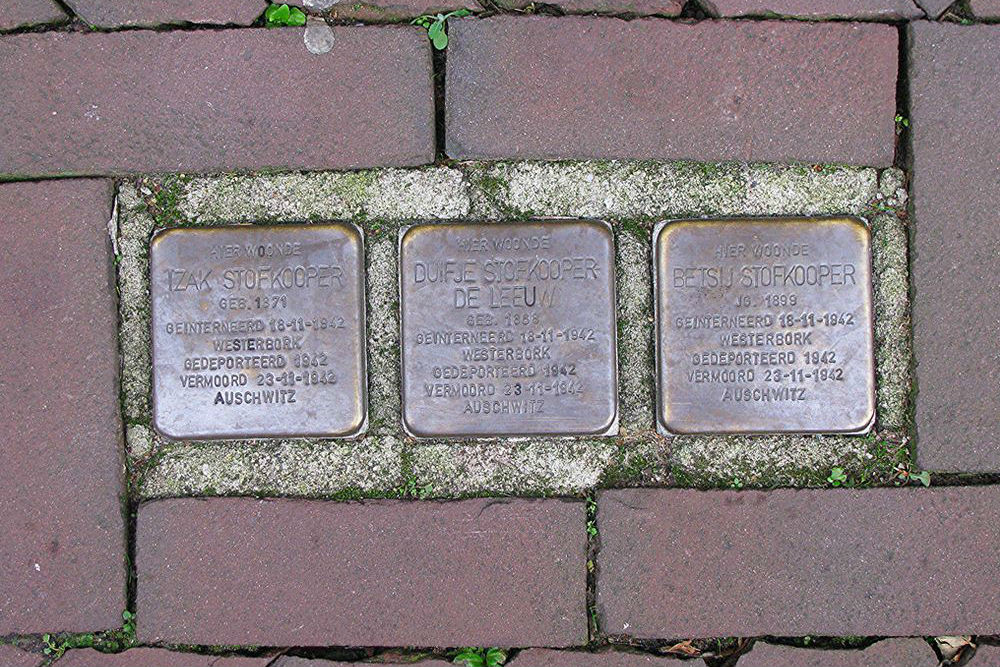Stumbling Stones Oldenzaalsestraat 40
These small, brass, memorial plaques (Stolpersteine or stumbling stones) commemorate:
* Izak Stofkooper, born 1871, interned 18 November 1942 Westerbork, deported 1942, murdered 23 November 1942 Auschwitz.
* Duifje Stofkooper-De Leeuw, born 1868, interned 18 November 1942 Westerbork, deported 1942, murdered 23 November 1942 Auschwitz.
* Betsij Stofkooper, born 1899, interned 18 November 1942 Westerbork, deported 1942, murdered 23 November 1942 Auschwitz.
Izak Stofkooper, an antique dealer and Duifje De Leeuw married and had one daughter, Betsij, who lived with them and worked as a domestic servant. All three were taken to Westerbork on 18 November 1942, quickly deported to Auschwitz and killed there. Izak was 71, Duifje 74 and Betsij 43.
Izak is listed in Yad Vashem as Yitzkhak Izak Stofkooper. He had one other sibling; details of her death are unknown. Of Duifje’s five brothers and sisters known to have been alive at the beginning of WW2, three were killed in Auschwitz or Sobibor; two survived.
"Stolpersteine" is an art project for Europe by Gunter Demnig to commemorate victims of National Socialism (Nazism). Stolpersteine (stumbling stones) are small brass plaques placed in the pavement in front of the last voluntary residence of (mostly Jewish) victims who were murdered by the Nazis. Each plaque is engraved with the victim’s name, date of birth and place (mostly a concentration camp) and date of death. By doing this, Gunter Demnig gives an individual memorial to each victim. One stone, one name, one person. He cites the Talmud: "A human being is forgotten only when his or her name is forgotten."
Borne was the first town in the Netherlands in which Stolpersteine were placed -- on 29 November 2007.
Do you have more information about this location? Inform us!
Source
- Text: Fedor de Vries & Anne Palmer
- Photos: Ed Sijmons
- Joods Monument
- Geni.com
- Stolpersteine.eu
Nearby
Point of interest
- Former Higher Textile School De Maere, Enschede - Enschede
- Bicycle storage Lonneker Enschede City Hall - Enschede
- Jewish Synagogue Enschede - Enschede
Monument
- Memorial Zwanenburg - Enschede
- The Dutch East Indies Memorial Enschede - Enschede
- Memorial Air-Raid Shelter Floresstraat Enschede - Enschede
Cemetery
- Jewish War Graves Enschede - Enschede
- Commonwealth War Graves Oosterbegraafplaats Enschede - Enschede
- Dutch War Graves Roman Catholic Cemetery Enschede - Enschede
Remembrance Stone
- Stumbling Stones Gronaustraat 29 (now De Klomp 75) - Enschede
- Stumbling Stone Veenstraat 8 - Enschede
- Stumbling Stones Stadsgravenstraat 67 - Enschede
Fortification
- German Gefechtsstand Twente Airfield - Enschede
- Bunker Landing Strip Twente Airfield - Lonneker-West
- Remains German Flak tower - Lonneker-West





